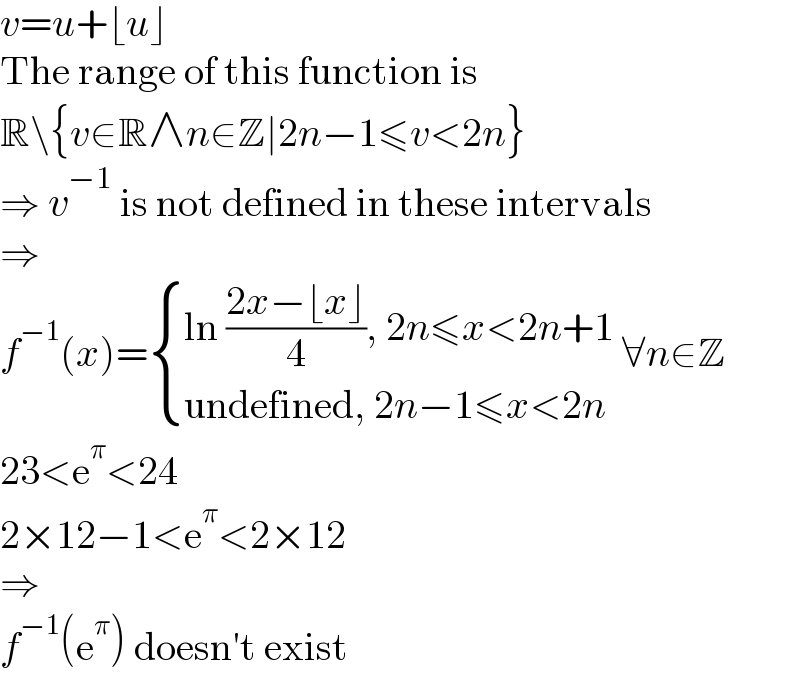
Question Number 199405 by mnjuly1970 last updated on 03/Nov/23

$$ \\ $$$$\:\:\:\:\:\:\:\:\:\:\mathrm{calculate}\:... \\ $$$$\:\:\mathrm{Q}:\:\:\:\:\:\:\mathrm{I}{f}\:\:,\:\:\:{f}\left({x}\right)\:=\mathrm{2}\:{e}^{{x}} \:−\mathrm{1}\:+\:\lfloor{e}^{{x}} +\:\frac{\mathrm{3}}{\mathrm{2}}\:+\lfloor{e}^{{x}} \rfloor\:\rfloor \\ $$$$\:\:\:\:\:\:\:\:\:\Rightarrow\:\:\:\:{f}\:^{−\mathrm{1}} \:\left(\:\frac{\pi}{\mathrm{4}}\:\right)\:=? \\ $$$$\:\:\:\:\: \\ $$
Answered by Frix last updated on 03/Nov/23

$$\mathrm{e}^{{x}} ={i}+{f};\:{i}\in\mathbb{Z}\wedge\mathrm{0}\leqslant{f}<\mathrm{1} \\ $$$$\mathrm{e}^{\pi} =\mathrm{23}+\zeta \\ $$$$\mathrm{2}\left({i}+{f}\right)−\mathrm{1}+\lfloor{i}+{f}+\mathrm{1}+\frac{\mathrm{1}}{\mathrm{2}}+\lfloor{i}+{f}\rfloor\rfloor=\mathrm{23}+\zeta \\ $$$$\mathrm{2}{i}−\mathrm{1}+\mathrm{2}{f}+\lfloor\mathrm{2}{i}+\mathrm{1}+{f}+\frac{\mathrm{1}}{\mathrm{2}}\rfloor=\mathrm{23}+\zeta \\ $$$$\mathrm{4}{i}+\mathrm{2}{f}+\lfloor{f}+\frac{\mathrm{1}}{\mathrm{2}}\rfloor=\mathrm{23}+\zeta \\ $$$$\mathrm{0}\leqslant{f}<\frac{\mathrm{1}}{\mathrm{2}} \\ $$$$\mathrm{4}{i}+\mathrm{2}{f}=\mathrm{23}+\zeta\:\Rightarrow\:{i}=\frac{\mathrm{23}}{\mathrm{4}}\notin\mathbb{Z} \\ $$$$\frac{\mathrm{1}}{\mathrm{2}}\leqslant{f}<\mathrm{1}\:\Rightarrow\:\mathrm{0}\leqslant\mathrm{2}{f}−\mathrm{1}<\mathrm{1} \\ $$$$\mathrm{4}{i}+\mathrm{2}+\left(\mathrm{2}{f}−\mathrm{1}\right)=\mathrm{23}+\zeta\:\Rightarrow\:{i}=\frac{\mathrm{21}}{\mathrm{4}}\notin\mathbb{Z} \\ $$$$\Rightarrow\:{f}\left({x}\right)\neq\mathrm{e}^{\pi} \\ $$$$\Rightarrow\:{f}^{−\mathrm{1}} \left(\mathrm{e}^{\pi} \right)\:\mathrm{does}\:\mathrm{not}\:\mathrm{exist} \\ $$
Commented by Frix last updated on 03/Nov/23

$$\mathrm{Please}\:\mathrm{correct}\:\mathrm{me}\:\mathrm{if}\:\mathrm{I}'\mathrm{m}\:\mathrm{wrong}. \\ $$
Commented by mnjuly1970 last updated on 03/Nov/23

$$\:\:{thank}\:{you}\:{so}\:{much}\:{sir} \\ $$$${for}\:{your}\:\:{effort}\:. \\ $$
Answered by mnjuly1970 last updated on 03/Nov/23

$$\:\:\:{my}\:{solution} \\ $$$$\:\:\:\:\:{f}\left({x}\right)=\mathrm{2}{e}^{{x}} −\mathrm{1}\:+\:\lfloor{e}^{{x}} \rfloor\:+\:\lfloor\:{e}^{{x}} \:+\frac{\mathrm{1}}{\mathrm{2}}\rfloor+\mathrm{1} \\ $$$$\:\:\:\:\:\:\:\:\:\:\:\:=\:\mathrm{2}{e}^{{x}} +\:\lfloor\mathrm{2}{e}^{{x}} \rfloor \\ $$$$−−−−− \\ $$$$\:\:\:\:\:{y}=\:\mathrm{2}{e}^{{x}} +\:\lfloor\:\mathrm{2}{e}^{{x}} \rfloor\:\Rightarrow\:{x}=\:\mathrm{2}{e}^{{y}} \:+\:\lfloor\mathrm{2}{e}^{{y}} \rfloor \\ $$$$\:\:\:\:\:\:\lfloor{x}\:\rfloor=\mathrm{2}\:\lfloor\mathrm{2}{e}^{{y}} \rfloor\Rightarrow\:\lfloor\mathrm{2}{e}^{{y}} \rfloor=\frac{\lfloor{x}\rfloor}{\mathrm{2}} \\ $$$$\:\:\:−−−− \\ $$$$\:\:\:\:{x}\:=\:\mathrm{2}{e}^{{y}} \:+\frac{\lfloor{x}\rfloor}{\mathrm{2}}\:\:\Rightarrow\:\:{y}\:=\:{ln}\left(\frac{{x}}{\mathrm{2}}−\frac{\lfloor{x}\rfloor}{\mathrm{4}}\right) \\ $$$$ \\ $$$$\:\:\:\:\:{f}^{\:−\mathrm{1}} \left({x}\right)\:=\:{ln}\left(\frac{{x}}{\mathrm{2}}−\frac{\lfloor{x}\rfloor}{\mathrm{4}}\right) \\ $$$$\:\:\:\:\:\:{f}\:^{−\mathrm{1}} \left(\frac{\pi}{\mathrm{4}}\:\right)=\:{ln}\left(\frac{\pi}{\mathrm{8}}\:\right)\:\Leftrightarrow\:{f}\left({ln}\left(\frac{\pi}{\mathrm{8}}\right)\right)=\frac{\pi}{\mathrm{4}} \\ $$$$\:\: \\ $$
Commented by Frix last updated on 03/Nov/23

$${f}\left({x}\right)=\mathrm{2e}^{{x}} +\lfloor\mathrm{2e}^{{x}} \rfloor \\ $$$$\underset{{x}\rightarrow\left(\mathrm{ln}\:\mathrm{6}\right)^{−} } {\mathrm{lim}}\:{f}\left({x}\right)\:=\mathrm{23} \\ $$$$\underset{{x}\rightarrow\left(\mathrm{ln}\:\mathrm{6}\right)^{+} } {\mathrm{lim}}\:{f}\left({x}\right)\:=\mathrm{24} \\ $$$$\mathrm{e}^{\pi} \approx\mathrm{23}.\mathrm{1407} \\ $$$$\Rightarrow\:\forall{x}\in\mathbb{R}:\:{f}\left({x}\right)\neq\mathrm{e}^{\pi} \\ $$$$====================== \\ $$$${f}\left({x}\right)=\mathrm{2e}^{{x}} +\lfloor\mathrm{2e}^{{x}} \rfloor \\ $$$${f}^{−\mathrm{1}} \left({x}\right)=\mathrm{ln}\:\frac{\mathrm{2}{x}−\lfloor{x}\rfloor}{\mathrm{4}} \\ $$$${f}^{−\mathrm{1}} \left({f}\left({x}\right)\right)={x}\:\mathrm{but}\:{f}\left({f}^{−\mathrm{1}} \left({x}\right)\right)\neq{x} \\ $$$$\mathrm{This}\:\mathrm{is}\:\mathrm{strange}...\: \\ $$$${f}^{−\mathrm{1}} \left(\mathrm{e}^{\pi} \right)=\mathrm{ln}\:\frac{\mathrm{2e}^{\pi} −\mathrm{23}}{\mathrm{4}} \\ $$$$\mathrm{But} \\ $$$${f}\left(\mathrm{ln}\:\frac{\mathrm{2e}^{\pi} −\mathrm{23}}{\mathrm{4}}\right)=\mathrm{e}^{\pi} −\frac{\mathrm{1}}{\mathrm{2}} \\ $$$$\mathrm{So}\:\mathrm{there}'\mathrm{s}\:\mathrm{something}\:\mathrm{wrong}. \\ $$
Commented by Frix last updated on 03/Nov/23

$${v}={u}+\lfloor{u}\rfloor \\ $$$$\mathrm{The}\:\mathrm{range}\:\mathrm{of}\:\mathrm{this}\:\mathrm{function}\:\mathrm{is} \\ $$$$\mathbb{R}\backslash\left\{{v}\in\mathbb{R}\wedge{n}\in\mathbb{Z}\mid\mathrm{2}{n}−\mathrm{1}\leqslant{v}<\mathrm{2}{n}\right\} \\ $$$$\Rightarrow\:{v}^{−\mathrm{1}} \:\mathrm{is}\:\mathrm{not}\:\mathrm{defined}\:\mathrm{in}\:\mathrm{these}\:\mathrm{intervals} \\ $$$$\Rightarrow \\ $$$${f}^{−\mathrm{1}} \left({x}\right)=\begin{cases}{\mathrm{ln}\:\frac{\mathrm{2}{x}−\lfloor{x}\rfloor}{\mathrm{4}},\:\mathrm{2}{n}\leqslant{x}<\mathrm{2}{n}+\mathrm{1}}\\{\mathrm{undefined},\:\mathrm{2}{n}−\mathrm{1}\leqslant{x}<\mathrm{2}{n}}\end{cases}\:\forall{n}\in\mathbb{Z} \\ $$$$\mathrm{23}<\mathrm{e}^{\pi} <\mathrm{24} \\ $$$$\mathrm{2}×\mathrm{12}−\mathrm{1}<\mathrm{e}^{\pi} <\mathrm{2}×\mathrm{12} \\ $$$$\Rightarrow \\ $$$${f}^{−\mathrm{1}} \left(\mathrm{e}^{\pi} \right)\:\mathrm{doesn}'\mathrm{t}\:\mathrm{exist} \\ $$
Commented by mnjuly1970 last updated on 03/Nov/23

$${thanks}\:{alot}\:{sir}.{you}\:{are}\:{right} \\ $$$${that}\:{was}\:{my}\:{mistake} \\ $$$$\:\:{i}\:{corrected}\:{the}\:{question}\:... \\ $$$$\:\:\:\: \\ $$
Commented by Frix last updated on 03/Nov/23

$$\mathrm{You}'\mathrm{re}\:\mathrm{welcome},\:\mathrm{working}\:\mathrm{on}\:\mathrm{these}\:\mathrm{things} \\ $$$$\mathrm{keeps}\:\mathrm{my}\:\mathrm{brain}\:\mathrm{young}. \\ $$
